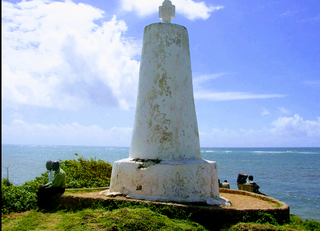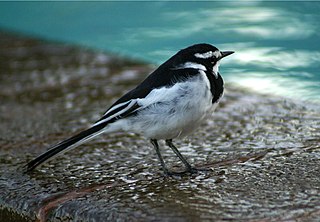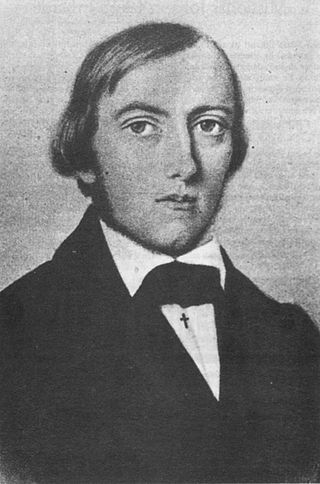
Mombasa is a coastal city in southeastern Kenya along the Indian Ocean. It was the first capital of British East Africa, before Nairobi was elevated to capital city status. It now serves as the capital of Mombasa County. The town is known as "the white and blue city" in Kenya. It is the country's oldest and second-largest city after the capital Nairobi, with a population of about 1,208,333 people according to the 2019 census. Its metropolitan region is the second-largest in the country, and has a population of 3,528,940 people.

Malindi is a town on Malindi Bay at the mouth of the Sabaki River, lying on the Indian Ocean coast of Kenya. It is 120 kilometres northeast of Mombasa. The population of Malindi was 119,859 as of the 2019 census. It is the largest urban centre in Kilifi County.

Johann Ludwig Krapf was a German missionary in East Africa, as well as an explorer, linguist, and traveler. Krapf played an important role in exploring East Africa with Johannes Rebmann. They were the first Europeans to see Mount Kenya with the help of Akamba who dwelled at its slopes and Kilimanjaro. Ludwig Krapf visited Ukambani, the homeland of the Kamba people, in 1849 and again in 1850. He successfully translated the new testament to the Kamba language. Krapf also played a key role in exploring the East African coastline, especially in Mombasa.

The Church Mission Society (CMS), formerly known as the Church Missionary Society, is a British mission society working with the Christians around the world. Founded in 1799, CMS has attracted over nine thousand men and women to serve as mission partners during its 200-year history. The society has also given its name "CMS" to a number of daughter organisations around the world, including Australia and New Zealand, which have now become independent.

The Anglican Church of Kenya (ACK) is a province of the Anglican Communion, and it is composed by 41 dioceses. The current Primate and Archbishop of Kenya is Jackson Ole Sapit. The Anglican Church of Kenya claims 5 million total members. According to a study published in the Journal of Anglican Studies and by Cambridge University Press, the ACK claims 5 million adherents, with no official definition of membership, with nearly 2 million officially affiliated members, and 310,000 active baptised members. The church became part of the Province of East Africa in 1960, but Kenya and Tanzania were divided into separate provinces in 1970.

Kilifi County was formed in 2010 as a result of a merger of Kilifi District and Malindi District, Kenya. Its capital is Kilifi and its largest town is Malindi. Kilifi county is one of the five counties that make up the Kenyan Coast. The county has a population of 1,453,787 people following the 2019 census which covers an area of 12,245.90 km2 (4,728.17 sq mi).

Johannes Rebmann was a German missionary, linguist, and explorer credited with feats including being the first European, along with his colleague Johann Ludwig Krapf, to enter Africa from the Indian Ocean coast. In addition, he was the first European to find Kilimanjaro. News of Rebmann's discovery was published in the Church Missionary Intelligencer in May 1849, but disregarded as mere fantasy for the next twelve years. The Geographical Society of London held that snow could not possibly occur let alone persist in such latitudes and considered the report to be the hallucination of a malaria-stricken missionary. It was only in 1861 that researchers began their efforts to measure Kilimanjaro. Expeditions to Tanzania between 1861 and 1865, led by the German Baron Karl Klaus von der Decken, confirmed Rebmann's report. Together with his colleague Johann Ludwig Krapf they were also the first Europeans to visit and report Mount Kenya. Their work there is also thought to have had effects on future African expeditions by Europeans, including the exploits of Sir Richard Burton, John Hanning Speke, and David Livingstone. After losing most of his eyesight and entering into a brief marriage, he died of pneumonia.
The National Council of Churches of Kenya (NCCK), (in Swahili, Baraza kuu la makanisa nchini Kenya) is a fellowship of Protestant churches and Christian organisations registered in Kenya. It is currently Chaired by the Africa Brotherhood Church (ABC) Archbishop Dr. Timothy N. Ndambuki. Its motto is "For Wananchi" which means "for citizens" (Wananchi meaning citizens in Swahili): This motto has been exemplified in NCCK's long involvement in public service, advocacy, and social responsibility in Kenya. It is a member of the Fellowship of Christian Councils and Churches in the Great Lakes and Horn of Africa and the Fellowship of Christian Councils in Southern Africa.
Karl Wilhelm Isenberg, spelt or known by names Carl Wilhelm Isenberg or Charles William Isenberg or C. W. Isenberg or Carl W. Isenberg or Charles Isenberg, was a German Church Missionary Society missionary and linguist to East Africa and Western India.
The Rabai Museum is a museum located in Kenya. The museum is located in the first Christian church building constructed in Kenya. Much of the museum focuses on the work of Johann Ludwig Krapf, who built the church with Johannes Rebmann. The museum is housed in one of the first churches built in Kenya.

Johann Jakob Erhardt, or John James Erhardt, was a German missionary and explorer who worked in East Africa and India. Although he remained on or near the coast of East Africa, he contributed to European knowledge of the interior through gathering descriptions from local people who had traveled there. His map of the region stimulated dispatch of the expedition of Burton and Speke.
Lake Uniamési or the Uniamesi Sea was the name given by missionaries in the 1840s and 1850s to a huge lake or inland sea they supposed to lie within a region of Central East Africa with the same name.

Abdilahi Nassir was a Kenyan Shia cleric based in Mombasa. Though raised a Sunni, Nassir converted to Shiism, and in the wake of Iran's Islamic revolution publicly identified himself as Twelver Shia.
The Lumbwa were a pastoral community which inhabited southern Kenya and northern Tanzania. The term Lumbwa has variously referred to a Kalenjin-speaking community, portions of the Maa-speaking Loikop communities since the mid-19th century, and to the Kalenjin-speaking Kipsigis community for much of the late 19th to mid-20th centuries.

Chief Kivoi Mwendwa was a Kamba long-distance trader who lived in the present day Kitui. Kivoi is most famous for guiding missionaries into the interior of the present day Kenya after he guided the German missionaries Johann Ludwig Krapf and Johannes Rebmann of the Anglican Church Missionary Society (CMS). During the trips, both Rebmann and Krapf came within visual distance of Mount Kenya.
The Loikop people, also known as Wakuafi, Kor, Mu-Oko, Muoko/Ma-Uoko and Mwoko, were a tribal confederacy who inhabited present-day Kenya in the regions north and west of Mount Kenya and east and south of Lake Turkana. The area is roughly conterminous with Samburu and Laikipia Counties and portions of Baringo, Turkana and (possibly) Meru Counties. The group spoke a common tongue related to the Maasai language, and typically herded cattle. The Loikop occasionally interacted with the Cushitic, Bantu, and Chok peoples. The confederacy had dispersed by the 21st century.
Arthur Cornwallis Madan (1846–1917) was a British linguist and Anglican missionary who became famous for his research on African languages and his Swahili dictionaries.

Mrima or Mrima Coast is the traditional name for the part of the East African coast facing Zanzibar. The inhabitants were often called "Wamrima" or Mrima people even though they could belong to different tribes and language groups.
All Saints' Cathedral, Nairobi is a Cathedral of the Anglican Church of Kenya (ACK).

Rebecca Wakefield born Rebecca Brewin was a British Methodist missionary wife who worked and died in what is now Kenya.












